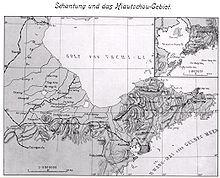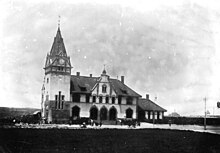Schantung Railway
The Shāndōng Railway , (in German literature also Schantung or Shantung Railway ), is a railway line in China that connects Qingdao with the provincial capital of Jinan in the Chinese province of Shāndōng , about 400 km to the west .
history
It was built by the Schantung-Eisenbahn-Gesellschaft , an amalgamation of various German banks, including the Mendelssohn & Co. , shipowner and mining company, between 1899 and 1904 under the supervision of the engineer Friedrich Kramer . The company's technical director was initially the railway engineer Alfred Gaedertz , who had also been entrusted with preliminary planning tasks. The aim was to develop the hinterland of the German " model colony " Kiautschou and to improve the transport of goods, especially coal and iron ore, which were intended for export to the German Empire . From Tsinan it had a connection to the entire Chinese railway network and thus also to the Trans-Siberian Railway . One could drive from Berlin to Tsingtau in twelve to fourteen days.
The construction of the railway line aroused strong opposition from the Chinese population. It was pushed forward quickly, without sufficiently clarifying the ownership structure and without taking into account the local population and the sometimes sensitive ecosystem of the region. The company also paid late or a below average price for land. In order to break the resistance, the governor of Kiautschou, Paul Jaeschke , had soldiers sent to the relevant regions, including Gaomi . Ongoing disputes and the flare-up of the Boxer Rebellion led to multiple destruction of the railway and telegraph connections in 1900 , which provoked further punitive actions on the part of the governor and the stock corporation. After the permanent stationing of soldiers, the construction of barracks and the systematic destruction of villages and the rural population, there was ultimately no further resistance to the construction of the railway line. The line between Tsingtau (now Qingdao) and Tsinanfu (now Jinan) was put into operation in 1904. From 1907, Julius Dorpmüller , who later became General Director of the Reichsbahn and Minister of Transport, was the head of the technical office of the Schantung Railway.
In 2008, the Zibo railway accident occurred on the route with 72 dead.
See also
literature
- Franz Baltzer : The Schantung Railway (Kaio-Tsi Railway). In: Verkehrstechnik , Volume 5, No. 35 (August 29, 1924), pp. 367–369.
- Kuo Heng-Yü; Mechthild Leutner (Ed.): Germany and China. Contributions to the Second International Symposium on the History of German-Chinese Relations, Berlin 1991. KG Saur Verlag, Munich 1994, ISBN 3-597-10617-X .
- Kuo Heng-Yü; Mechthild Leutner (ed.): Contributions to German-Chinese relations. KG Saur Verlag, Munich 1986, ISBN 3-597-10599-8 .
- Mechthild Leutner (Ed.): "Kiautschou Model Colony". The expansion of the German Empire in China. German-Chinese relations 1897–1914. A collection of sources. Akademie Verlag, Berlin 1997
- Klaus Mühlhahn: Rule and resistance in the 'model colony' Kiautschou. Oldenbourg 2000, ISBN 978-3486564655 .
- Vera Schmidt: The German railway policy in Shantung, 1897-1914. A contribution to the history of German imperialism in China. Harrassowitz, Wiesbaden 1976, ISBN 3-447-01744-9 .
- Claudia Wendels: The Schantung Railway. The interest of the financial world in the German railway line in East China, Siegburg 2012, ISBN 978-3-938535-77-6 .
Web links
- The emergence of the "model colony" Kiautschou , Federal Archives
- Deutsches Historisches Museum: German outposts in the hinterland. The infrastructural penetration of the Shantung Province
- Review of " Die Sandelholzstrafe " novel by Mo Yan , Deutschlandradio Kultur , October 22, 2009
Individual evidence
- ↑ a b Mechthild Leutner (ed.): "Model colony Kiautschou". The expansion of the German Empire in China. German-Chinese relations 1897–1914. A collection of sources. Akademie Verlag, Berlin 1997
- ^ Mechthild Leutner (Ed.): Contributions to the German-Chinese relations. Munich 1986, p. 122
- ^ "German troops deployed in Shandong after the 'Jiao'ao lease agreement' was signed", in: Kuo Heng-Yü; Mechthild Leutner (Ed.): Germany and China. Contributions to the Second International Symposium on the History of German-Chinese Relations Berlin 1991. KG Saur Verlag , Munich 1994, p. 322




